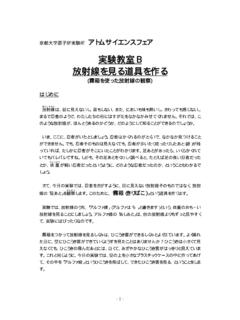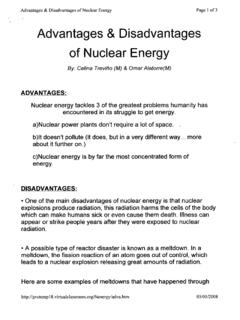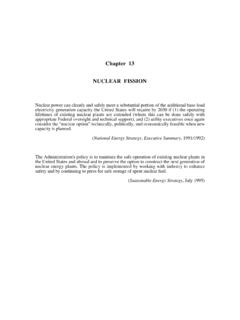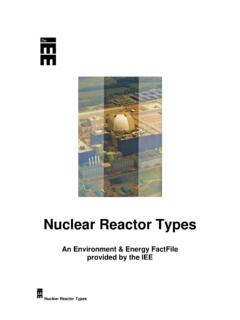Transcription of The Chernobyl Reactor: Design Features and Reasons for ...
1 11 The Chernobyl Reactor: Design Features and Reasons for Accident Mikhail V. MALKO Joint Institute of Power and nuclear Research, National Academy of Sciences of Belarus Krasin , Minsk, Sosny, 220109, Republic of Belarus: Abstracts The report describes the main Features of the Chernobyl reactor and possible Reasons of the accident that happened on 26 April 1986. Analysis of scientific results established after the accident demonstrates that shortcomings in the Design , and freak infringements of safety regulations for the construction as well as inadequate documentation for reactor operation were the main reason of the Chernobyl accident.
2 Various scenarios proposed for this accident are also analyzed in the report. It is concluded that a very high probability of the nuclear explosions at the reactor of the Unit 4 of the Chernobyl accident exists. The power of it could be equivalent to 200 tons of the trinitrotoluene (TNT). Introduction The accident at Unit 4 of the Chernobyl nuclear Power Plant (NPP) on 26 April 1986 is the most severe accident in the history of the peaceful use of the nuclear energy.
3 As a result of this accident the reactor of the fourth unit of the Chernobyl accident was fully destroyed. This caused a release of a very high amount of radioactive species into the environment. The total activity of all radionuclides that escaped from the active core of the reactor during 10 days after the explosions is assessed as approximately 1019 Bq [1]. The Reasons for the Chernobyl accident and its consequences were the subject of the Post-Accident Review Meeting held on 25-29 August 1986 in Vienna, Austria [2].
4 It was organized under the auspices of the IAEA. The Soviet experts reported at the meeting their version of the Reasons of the accident as well as its possible consequences [3]. The accident occurred during a turbogenerator test carried out at the chance of the shutdown of the unit for a planned maintenance. The destruction of the reactor happened 6-7 seconds after the operator pressed the scram button, AZ-5 to insert all control rods into the core. According to the Soviet experts the prime cause of the accident at the Chernobyl NPP was.
5 An extremely improbable combination of violations of instructions and operating rules committed by the staff of the unit [3]. This conclusion sets a full responsibility for the accident at the Chernobyl NPP on its stuff. Participants of the Post-Accident Review Meeting [2] also accepted the Soviet version. However, it was incorrect. This was demonstrated in 1990 by the commission of the State Committee for Atomic Safety Survey of the USSR which concluded that the main Reasons of the Chernobyl accident were serious shortcomings in the Design of the Chernobyl reactor as well as inadequate documents regulating a safe operation of the reactor [4].
6 Various errors, that were made during the turbogenerator testing by the personnel of the fours unit of the Chernobyl NPP, according to the commission, could only contribute to the development of the accident. This commission will be named in the present report as the Sternberg commission after the name of its chairman. The conclusions of the Sternberg commission were accepted later by the International Consultative Group on the nuclear Safety that issued in 1993 a Supplement to INSAG-1 [5].
7 In this report of the International Consultative Group on the nuclear Safety, the main accent was laid also on various shortcomings of the RBMK Design . At the same time the International Consultative Group on the nuclear Safety indicated that the important reason of the Chernobyl accident was an inadequate nuclear safety 12culture in the nuclear industry of the former USSR. Main Design Features of the RBMK reactor History of the RBMK The abbreviation RBMK means in Russian: a channel-туре reactor of a large power.
8 There were two modifications of the RBMKs in the USSR: RBMK-1000 and RBMK-1500. They differ only in their capacity. The RBMK-1000 has the nominal power equal 1000 MW electrical gross. The nominal capacity of the RBMK-1500 is 1500 MW electrical gross. Some principal characteristics of the RBMK-1000 are given in Table 1. It is a kind of a boiling water reactor with enriched uranium as fuel, graphite as moderator and water as coolant. Reactors of this type were constructed and operated only in the USSR.
9 The construction of the first RBMK was begun in March 1970 (Leningrad NPP) [6]. It was put into the commercial operation in November 1974. Later other 14 RBMK reactors were constructed and put into operation in the USSR before the Chernobyl accident [6]. Thus, 15 RBMK reactors were in operation in the USSR at the time of the Chernobyl accident. They were 4 reactors at the Leningrad NPP, 4 at the Chernobyl NPP, 4 at the Kursk NPP, 2 at the Smolensk NPP and 1 at the Ignalina NPP [6].
10 The RBMK reactors were built in pairs, with two units occupying opposite sides of a single building complex. Turbogenerators of such pair of reactor units were constructed in one building. Reactors of the first two units of the Leningrad, Chernobyl and Kursk NPPs belong to the first generation of RBMKs. The other RBMKs belong to the second generation of the reactors of this type. The difference between RBMKs of the first and second generations was not very significant.










